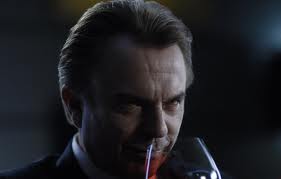There are things we’re prone to asking people when we’re getting to know them. Questions that give us a pretty basic grasp for what kind of people they are. “What line of work are you in?”, “Where are you from?”, “What’s your major?”, “What are your hobbies?”
You know the stuff.
And common among these ice breaker questions is “So… what kind of movies do you like?”
You wouldn’t imagine that there’d be a wrong answer to that question.
But there is.
Oh man, is there ever.
You can give any answer to that question, so long as you don’t say “horror”.
You say that, and the conversation stops dead.
Look, I can get why people would be put-off by that- there, after all, a pretty deeply rooted stereotype of horror as being nothing more than scantily clothed teens being massacred in the wilderness by deformed, machete-wielding maniacs.
But that’s the thing- while those films are probably the most recognizable of the horror genre’s [hideously deformed] face, there’s so much to horror than just that. I mean, the action genre is made up of more than the unholy explosive-ridden spawn of Michael Bay.
And we certainly don’t imagine that romance movies are nothing but hours of vapid and vacuous dialogue.
So why do people react so viciously to horror?
I think it’s because people have (1) an incomplete understanding of what horror is and (2) and incomplete understanding of why we watch it.
First- full disclosure. There are a ton of bad horror movies out there. They don’t require much plot, the can use nobody actors, and they’re cheap and easy to throw together. They appeal to the lowest common denominator, and they can flood the market however- this cannot be used to criticize the horror genre anymore than trashy romance novels can be used criticize contemporary fiction.
Now, let’s hash out exactly what “horror” is.
If we consult the fountain of all earthly knowledge that is Wikipedia, we find “Horror Film” defined as “…unsettling movies that strive to elicit the emotions of fear, disgust and horror from viewers. They often feature scenes that startle the viewer through the means of macabre and the supernatural, thus frequently overlapping with the fantasy and science fiction genres.”
Ok, that’s pretty comprehensive, and it brings us to the question- “Why?”
Well, there’s no simple answer. As with any genre, there are different kinds of horror that we watch for different reasons. Let me give some examples.
Slasher Films:
Slasher films (also commonly known as “splatter films” or “teen screams”) are the films everyone thinks of when the subject of horror comes up. The campy b-movies from the 50s and 60s, the various incarnations of Friday the 13th and A Nightmare on Elm Street, the horror-action hybrids like Resident Evil– need I go on?
For the most part, there’s not a lot to these films. They’re made to make money, and we watch them for cheap thrills. When I was I kid, I used to go around in the garden below my apartment building looking for slugs, spiders, and other “gross” things. The slasher/splatter/teen scream films of today are just extensions of that same juvenile urge to be grossed out.
Take, for example, Sam Raimi’s 1981 film The Evil Dead.
If you look closely at the poster, you’ll see it’s titled “…The most ferociously original horror film of the year…”. Yeah- a bunch of teens in a cabin in the woods being killed by a malicious force (the kids, not the cabin) is something that’s never been done before.
All in all, there’s not much to it. The plot is predictable, the gore is excessive, the acting is (barring one scene) lousy, and special effects are just plain awful.
Again, there are a lot of these films out there because they’re easy to make. Most fans of these particular films are either (1) older people who feel a sentimental attachment to the films they saw as teens or (2) people who watch them for the comedic overacting.
“Boo!” Films:
To be perfectly honest- I’m not entirely sure of the title for this particular genre. These “boo!” films are a step about splatter movies in that they don’t require gore to frighten the audience, but are still fairly conventional- merely startling or alarming audiences with sudden “boo!” moments. Look at the 2010 remake of the classic horror film The Wolfman.
While there certainly wasn’t a lack of gore in this film, the frightening part of the film was in the “boo!” moments, when something would leap at the scream with a loud noise- jolting the audience. What I really loved about this particular film was that it would use “boo!”s twice. You’d get startled, and just after you’re calming down- bam!– another jolt. Again, while it’s not too different from slasher films, “boo!” films tend to be a step-up in quality, as the jolts are only effective when the audience is immersed in the story- either through a good story, atmospheric cinematography, or nice acting.
The exhilarating rush that we get from being startled is the central reason we watch these kinds of film. Same logic behind roller-coasters.
Psychological/Tension Films:
Here the line between the horror and thriller genres tend to overlap. When the violence, the gore, the monsters are all merely implied. What really scares you isn’t so much in what is shown (as in slasher films or “boo!” films) but in what’s concealed. Now this demands so much more of the film. Gore is easy, jolts are easy, but getting the audience creeped out by something they can’t see- that’s tough. As a result, these psychological horror films are really top-notch stuff, forcing the actors to be believable, the atmosphere to be consistent, the tension to be constantly mounting, and everyday objects to be sinister and threatening.
While there are a lot of good films I could list here (the photo above is from The Ring– US version), I’m going to go with Paranomal Activity. I’m guessing most of you know the basic premise; weird stuff happens in house, camera gets set up to catch whatever it is, things get worse from there. It sounds pretty simplistic, yet it’s easily one of the scariest films recently made. Why? Because it’s all in the minds of the audience. The evil force is never shown, letting audience members imagine whatever frightens them most.
It’s catharsis. We watch these films, as weird as it sounds, to relax. It’s like doing stretches- the further you pull, the more sore your muscles become- but when you release that tension you feel get, and wander around the rest of the day relaxed and limber. These movies simply serve as a psychological version of that.
Primal Fear Movies:
Now these movies are masterpieces. They’re the icons of horror not because of gore and not because of jolts and not because of tension (though they all play a part). No, these movies are the high-point of horror because they speak to our most primal fears. Being watched, strangers, the unknown- these are all things we, as a species, are naturally terrified of. These subconscious fears are the remains of old, primal instincts from a brutal and distant era. These horror films stick with us, even after we’ve left the theater or turned off the TV.
For example, 1975’s Jaws.
Did this movie have gore? Yes. Jolts? Yep. Tension? Plenty- but none of that is what defined this movie. What made Jaws the cultural staple it is today is that it spoke to our fear of the ocean and the monsters therein. The film actually caused a drop in the number of people going to the beach in 1975!
Or, look at another example. Alfred Hitchcock’s Psycho.
Does anyone who sees this film ever look at a shower or a staircase the same way again?
Now I guess I really haven’t answered the question as to why I watch horror.
To be honest, I think it’s because horror, as the genre that no one expects anything of, can get away with more. I mean, when was the last time you saw a non-horror film grapple with issues of faith and spirituality?
Or politics?
Let’s just face the facts- horror movies tend to be a lot braver than non-horror movies. They’ll deal with issues other films shy away from, and not only do they deal with those issues, but through a medium that this atmospheric and engaging on multiple levels.
Well- most of the time anyways…
























